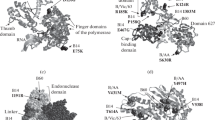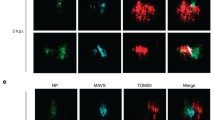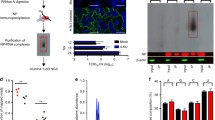Summary
The effect of β-decay of radionuclides incorporated into influenza virus on the properties of the two closely adjacent structures — RNA and nucleoprotein (NP) — was studied. The long-term storage of3H-uridine labelled influenza virus was shown to lead to the loss of infectivity. This effect may be explained by lethal intra-molecular modifications of viral RNA, caused by β-decay of3H incorporated into the molecule. There was an accompanying decrease of monoclonal antibody (MAB) binding activity, this also being a plausible result of β-decay. The different rates of inactivation of MAB binding activity of different epitopes of NP of the3H-labelled virus shown in our studies suggest that there are different types of structural organization or different location of these epitopes in the NP.
The effect of3H-decay on the intracellular RNA of reproducing virus lead to a decrease in virus yield; this may be due to radiation- and transmutation-induced damage of messenger and progeny RNA populations synthesized during the infection.
The storage of influenza virus labelled with14C-aminoacids lead to a decrease in MAB binding activity of the NP that was unaccompanied by a decrease in infectivity. Furthermore,14C-decay in proteins of reproducing virus had no adverse effect.
Similar content being viewed by others
References
Halpern A, Stöckling G (1977) Chemical and biological consequences of B-decay. Radiat Environ Biophys 14: 257–274
Hoffer KG, Hughes WL (1969) Radiotoxicity of intracellular3H,125I and131I. Radiat Res 47: 94–109
Hunter W, Greenwood F (1962) Preparation of iodine-131 labeled human growth hormone of high specific activity. Nature 194: 495–496
Jennings PA, Finch JT, Winter G, Robertson JS (1983) Does the higher order structure of the influenza virus RNP guide sequence rearrangements in influenza RNA? Cell 34: 619–627
Lvov DK, Bukrinskaya AG, Yamnikova SS, Krasko AG, Vichrev HE, Severin ES (1986) Monoclonal antibodies to NP-protein and their use for the diagnosis and study of influenza virus. Vopr Virusol 31: 655–657
Maniatis T, Fritsch EE, Sambrook J (1982) Biochemical methods. In: Maniatis T (ed) Molecular cloning. A laboratory manual. Cold Spring Harbor Lab, pp 464–466
Martin G, Bender M (1963) Survival kinetics of HeLa S-3 cells after incorporation of3H-uridine. Int J Radiat Biol 7: 221–233
Prokudina EN, Semenova NP, Zhdanov VM (1986) Detection of viral antigens by solid phase radioimmunoassay on polyethylene film. J Virol Methods 13: 27–33
Smirnov YA, Kolodkina VL, Kaverin NV (1984) On the participation of nitrogen bases in RNA-protein interactions in influenza virus RNP. Mol Genet Micro Virusol 8: 34–37
Tessman I (1959) Some unusual properties of the nucleic acid in the bacteriophages S13 and X174. Virology 7: 263–275
Van Wyke KL, Hinshaw VS, Beau WJ, Webster RG (1980) Antigenic variation of influenza A virus detected with monoclonal antibodies. J Virol 35: 24–30
Wilson DE (1958) Radiation studies on the hemolysin of Newcastle disease virus. Radiat Res 8: 142–145
Author information
Authors and Affiliations
Rights and permissions
About this article
Cite this article
Prokudina, E.N., Semyonova, N.P., Yamnikova, S.S. et al. Effect of β-decay of radionuclides incorporated into influenza virus RNA and proteins on the infectivity of the virus and antigenicity of its nucleoprotein. Archives of Virology 97, 325–332 (1987). https://doi.org/10.1007/BF01314430
Received:
Accepted:
Issue Date:
DOI: https://doi.org/10.1007/BF01314430




